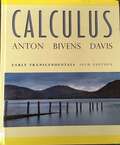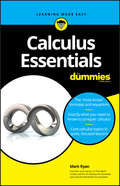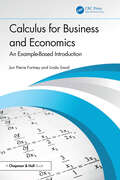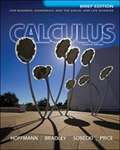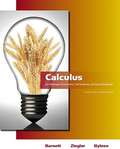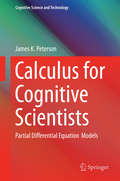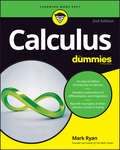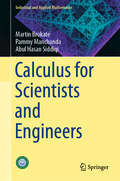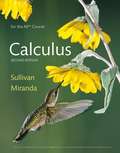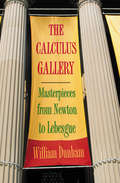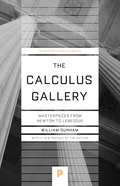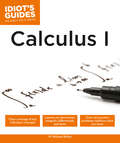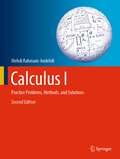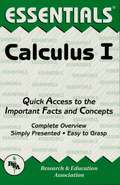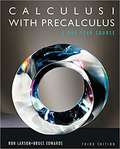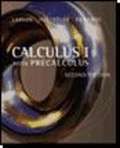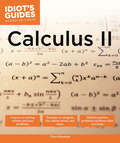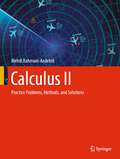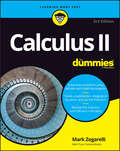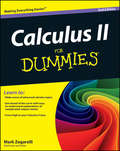- Table View
- List View
Calculus Early Transcendentals Single Variable
by Stephen Davis Howard Anton Irl C. BivensCalculus: Early Transcendentals, 10th Edition continues to evolve to fulfill the needs of a changing market by providing flexible solutions to teaching and learning needs of all kinds. Calculus: Early Transcendentals, 10th Edition excels in increasing student comprehension and conceptual understanding of the mathematics. The new edition retains the strengths of earlier editions: e.g., Anton's trademark clarity of exposition; sound mathematics; excellent exercises and examples; and appropriate level, while incorporating more skill and drill problems within WileyPLUS. <P><P>The seamless integration of Howard Anton's Calculus: Early Transcendentals, 10th Edition with WileyPLUS, a research-based, online environment for effective teaching and learning, continues Anton's vision of building student confidence in mathematics because it takes the guesswork out of studying by providing them with a clear roadmap: what to do, how to do it, and whether they did it right.
Calculus Essentials For Dummies
by Mark RyanCalculus Essentials For Dummies (9781119591207) was previously published as Calculus Essentials For Dummies (9780470618356). While this version features a new Dummies cover and design, the content is the same as the prior release and should not be considered a new or updated product. Many colleges and universities require students to take at least one math course, and Calculus I is often the chosen option. Calculus Essentials For Dummies provides explanations of key concepts for students who may have taken calculus in high school and want to review the most important concepts as they gear up for a faster-paced college course. Free of review and ramp-up material, Calculus Essentials For Dummies sticks to the point with content focused on key topics only. It provides discrete explanations of critical concepts taught in a typical two-semester high school calculus class or a college level Calculus I course, from limits and differentiation to integration and infinite series. This guide is also a perfect reference for parents who need to review critical calculus concepts as they help high school students with homework assignments, as well as for adult learners headed back into the classroom who just need a refresher of the core concepts. The Essentials For Dummies Series Dummies is proud to present our new series, The Essentials For Dummies. Now students who are prepping for exams, preparing to study new material, or who just need a refresher can have a concise, easy-to-understand review guide that covers an entire course by concentrating solely on the most important concepts. From algebra and chemistry to grammar and Spanish, our expert authors focus on the skills students most need to succeed in a subject.
Calculus for AP®
by Ron Larson Paul BattagliaCalculus for AP® is designed specifically to support the course frameworks for AP® Calculus AB and AP® Calculus BC. Ron Larson has partnered with an AP® Calculus teacher to develop a series that meets the needs of the AP® Calculus course while helping students develop mathematical knowledge conceptually. With a clear focus on course demands, Calculus for AP® introduces content in the sequence most preferred by AP® Calculus teachers, resulting in more complete content coverage.
Calculus for Business and Economics: An Example-Based Introduction
by Jon Pierre Fortney Linda SmailCalculus for Business and Economics: An Example-Based Introduction is designed for first-year university students specializing in business and economics. This book is crafted in a clear, easy-to-read style, covering all the essential calculus-related topics that students are likely to encounter in their studies. With real-world business and economics applications seamlessly integrated around the core calculus concepts, students will find the book of real practical value throughout their time in university and beyond. Features Three hundred easy-to-follow examples throughout, carefully crafted to illustrate the concepts and ideas discussed. Numerous exercises to practice, with solutions available online to help you learn at your own pace. Each chapter concludes with a section showcasing the real-world business and economics applications of the discussed mathematical concepts.
Calculus for Business, Economics, and the SocialaAnd Life Sciences
by Laurence D. Hoffmann Gerald L. Bradley Michael Price David SobeckiCalculus for Business, Economics, and the Social and Life Sciences, Brief Edition provides a sound, intuitive understanding of the basic concepts students need as they pursue careers in business, economics, and the life and social sciences. Students achieve success using this text as a result of the author's applied and real-world orientation to concepts, problem-solving approach, straight forward and concise writing style, and comprehensive exercise sets. More than 100,000 students worldwide have studied from this text!
Calculus For Business, Economics, Life Sciences And Social Sciences
by Raymond A. Barnett Michael R. Ziegler Karl E. ByleenThe content is organized into two parts: (1) A Library of Elementary Functions (Chapters 1&2) and (2) Calculus (Chapters 3-9). The book’s overall approach, refined by the authors’ experience with large sections of college freshmen, addresses the challenges of teaching and learning when readers’ prerequisite knowledge varies greatly. Reader-friendly features such as Matched Problems, Explore & Discuss questions, and Conceptual Insights, together with the motivating and ample applications, make this text a popular choice for today’s students and instructors.
Calculus for Business, Economics, Life Sciences, and Social Sciences
by Raymond Barnett Michael Ziegler Karl ByleenBarnett/Ziegler/Byleen is designed to help students help themselves succeed in the course. This text offers more built-in guidance than any other on the market–with special emphasis on prerequisites skills–and a host of student-friendly features to help students catch up or learn on their own.
Calculus for Business, Economics, Life Sciences, and Social Sciences, Brief Version
by Raymond Barnett Michael Ziegler Karl Byleen Christopher StockerHelps students “get the idea.” Calculus for Business, Economics, Life Sciences, and Social Sciences, Brief Version, 14th Edition offers more built-in guidance than any other text in its field ― with special emphasis on applications and prerequisite skills ― and a host of student-friendly features to help students catch up or learn on their own. The text’s emphasis on helping students “get the idea” is enhanced in the new edition by a design refresh, updated data and applications, and a robust MyLab™ Math course.
Calculus for Cognitive Scientists: Partial Differential Equation Models (Cognitive Science and Technology #0)
by James K. PetersonThis book provides a self-study program on how mathematics, computer science and science can be usefully and seamlessly intertwined. Learning to use ideas from mathematics and computation is essential for understanding approaches to cognitive and biological science. As such the book covers calculus on one variable and two variables and works through a number of interesting first-order ODE models. It clearly uses MatLab in computational exercises where the models cannot be solved by hand, and also helps readers to understand that approximations cause errors - a fact that must always be kept in mind.
Calculus For Dummies
by Mark RyanSlay the calculus monster with this user-friendly guide Calculus For Dummies, 2nd Edition makescalculus manageable--even if you're one of the many studentswho sweat at the thought of it. By breaking down differentiationand integration into digestible concepts, this guide helps youbuild a stronger foundation with a solid understanding of the bigideas at work. This user-friendly math book leads you step-by-stepthrough each concept, operation, and solution, explaining the "how"and "why" in plain English instead of math-speak. Through relevantinstruction and practical examples, you'll soon learn thatreal-life calculus isn't nearly the monster it's made out tobe.Calculus is a required course for many college majors, and forstudents without a strong math foundation, it can be a real barrierto graduation. Breaking that barrier down means recognizingcalculus for what it is--simply a tool for studying the waysin which variables interact. It's the logical extension of thealgebra, geometry, and trigonometry you've already taken, andCalculus For Dummies, 2nd Edition proves that ifyou can master those classes, you can tackle calculus and win.Includes foundations in algebra, trigonometry, and pre-calculusconceptsExplores sequences, series, and graphing common functionsInstructs you how to approximate area with integrationFeatures things to remember, things to forget, and things youcan't get away withStop fearing calculus, and learn to embrace the challenge. Withthis comprehensive study guide, you'll gain the skills andconfidence that make all the difference. Calculus For Dummies,2nd Edition provides a roadmap for success, and thebackup you need to get there.
Calculus For The Forgetful: How To Understand More And Memorize Less
by Wojciech K. Kosek“Calculus for the Forgetful: How to understand more and memorize less”, by Wojciech K Kosek, is one of the shortest calculus books available: it can be read in a couple of days if needed. Yet it provides a concise treatment of single variable calculus, along with many exercises and more than 130 examples. Informal, intuitive language is used to present the theory in a nutshell. This book is small enough to be carried around to other classes in which calculus is used, which is ideal for those who plan to take classes in physics, chemistry, economics, engineering, or more advanced mathematics courses. Those who are preparing for standardized tests will also benefit from the book. Also, an great complement to any of the comprehensive texts for students currently taking calculus. Students who major in areas such as mathematics or mathematics education, economics, engineering, physics or chemistry, will be especially glad to purchase “Calculus for the Forgetful”.
Calculus for Scientists and Engineers (Industrial and Applied Mathematics)
by Martin Brokate Pammy Manchanda Abul Hasan SiddiqiThis book presents the basic concepts of calculus and its relevance to real-world problems, covering the standard topics in their conventional order. By focusing on applications, it allows readers to view mathematics in a practical and relevant setting. Organized into 12 chapters, this book includes numerous interesting, relevant and up-to date applications that are drawn from the fields of business, economics, social and behavioural sciences, life sciences, physical sciences, and other fields of general interest. It also features MATLAB, which is used to solve a number of problems. The book is ideal as a first course in calculus for mathematics and engineering students. It is also useful for students of other sciences who are interested in learning calculus.
The Calculus Gallery
by William DunhamMore than three centuries after its creation, calculus remains a dazzling intellectual achievement and the gateway into higher mathematics. This book charts its growth and development by sampling from the work of some of its foremost practitioners, beginning with Isaac Newton and Gottfried Wilhelm Leibniz in the late seventeenth century and continuing to Henri Lebesgue at the dawn of the twentieth--mathematicians whose achievements are comparable to those of Bach in music or Shakespeare in literature. William Dunham lucidly presents the definitions, theorems, and proofs. "Students of literature read Shakespeare; students of music listen to Bach," he writes. But this tradition of studying the major works of the "masters" is, if not wholly absent, certainly uncommon in mathematics. This book seeks to redress that situation. Like a great museum, The Calculus Gallery is filled with masterpieces, among which are Bernoulli's early attack upon the harmonic series (1689), Euler's brilliant approximation of pi (1779), Cauchy's classic proof of the fundamental theorem of calculus (1823), Weierstrass's mind-boggling counterexample (1872), and Baire's original "category theorem" (1899). Collectively, these selections document the evolution of calculus from a powerful but logically chaotic subject into one whose foundations are thorough, rigorous, and unflinching--a story of genius triumphing over some of the toughest, most subtle problems imaginable. Anyone who has studied and enjoyed calculus will discover in these pages the sheer excitement each mathematician must have felt when pushing into the unknown. In touring The Calculus Gallery, we can see how it all came to be.
The Calculus Gallery: Masterpieces from Newton to Lebesgue (Princeton Science Library #60)
by William DunhamMore than three centuries after its creation, calculus remains a dazzling intellectual achievement and the gateway to higher mathematics. This book charts its growth and development by sampling from the work of some of its foremost practitioners, beginning with Isaac Newton and Gottfried Wilhelm Leibniz in the late seventeenth century and continuing to Henri Lebesgue at the dawn of the twentieth. Now with a new preface by the author, this book documents the evolution of calculus from a powerful but logically chaotic subject into one whose foundations are thorough, rigorous, and unflinching—a story of genius triumphing over some of the toughest, subtlest problems imaginable. In touring The Calculus Gallery, we can see how it all came to be.
Calculus I (Idiot's Guides)
by W. Michael KelleyLet's face it, most students don't take calculus because they find it intellectually stimulating. It's not . . . at least for those who come up on the wrong side of the bell curve! There they are, minding their own business, working toward some non-science related degree, when . . . BLAM! They get next semester's course schedule in the mail, and first on the list is the mother of all loathed college courses . . . CALCULUS! Not to fear—Idiot's Guides®: Calculus I is a curriculum-based companion book created with this audience in mind. This new edition continues the tradition of taking the sting out of calculus by adding more explanatory graphs and illustrations and doubling the number of practice problems! By the time readers are finished, they will have a solid understanding (maybe even a newfound appreciation) for this useful form of math. And with any luck, they may even be able to make sense of their textbooks and teachers.
Calculus I: Practice Problems, Methods, and Solutions
by Mehdi Rahmani-AndebiliThis study guide is designed for students taking a Calculus I course. This new edition includes expanded examples, questions, and practice problems that will help students to review and sharpen their knowledge of the subject and enhance their performance in the classroom. New material covered in the second edition includes types of functions, inverse functions, combinations of functions, domain and range of functions, axis of symmetry of functions, trigonometric equations and identities, limits and continuity, derivatives and their applications, and definite and indefinite integrals. Offering detailed solutions, multiple methods for solving problems, and clear explanations of concepts, this hands-on guide will improve students’ problem-solving skills and foster a solid understanding of calculus, which will benefit them in all of their calculus-based courses.
Calculus I Essentials
by Editors of REAREA's Essentials provide quick and easy access to critical information in a variety of different fields, ranging from the most basic to the most advanced. As its name implies, these concise, comprehensive study guides summarize the essentials of the field covered. Essentials are helpful when preparing for exams, doing homework and will remain a lasting reference source for students, teachers, and professionals. Calculus I covers functions, limits, basic derivatives, and integrals.
Calculus I with Precalculus
by Ron Larson Bruce Edwards David FalvoNIMAC-sourced textbook <P><P>CALCULUS I WITH PRECALCULUS, brings you up to speed algebraically within precalculus and transition into calculus. The Larson Calculus program has been widely praised by a generation of students and professors for its solid and effective pedagogy that addresses the needs of a broad range of teaching and learning styles and environments. Each title is just one component in a comprehensive calculus course program that carefully integrates and coordinates print, media, and technology products for successful teaching and learning. One primary objective guided the authors in writing this book: to develop precise, readable materials for students that clearly define and demonstrate concepts and rules of calculus.
Calculus I with Precalculus: A One-Year Course
by Ron Larson Robert Hostetler Bruce H. EdwardsFor students without access to the rich resources of Eduspace, this CD provides a wealth of learning resources including algorithmically-generated prerequisite skill practice, tutorial resources, and a color graphing calculator.
Calculus II (Idiot's Guides)
by Chris MonahanIdiot's Guides: Calculus II, like its counterpart Idiot's Guides: Calculus I, is a curriculum-based companion book that continues the tradition of taking the sting out of calculus by adding more explanatory graphs and illustrations in easy-to-understand language, practice problems, and even a test at the end. Idiot's Guides: Calculus II is geared for all students who need to succeed in calculus.Also included: • Complete step-by-step examples to help you work through the problems. • Advanced and complex problem examples. • Sidebar problems sprinkled throughout to test reader's knowledge with answer key in the back. • Practice test included at the end of the book, complete with answer key.
Calculus II: Practice Problems, Methods, and Solutions
by Mehdi Rahmani-AndebiliThis study guide is designed for students taking a Calculus II course. The textbook includes examples, questions, and practice problems that will help students to review and sharpen their knowledge of the subject and enhance their performance in the classroom. The material covered in the book includes applications of integration, sequences and series and their applications, polar coordinate systems, and complex numbers. Offering detailed solutions, multiple methods for solving problems, and clear explanations of concepts, this hands-on guide will improve students’ problem-solving skills and foster a solid understanding of calculus, which will benefit them in all of their calculus-based courses
Calculus II For Dummies
by Mark ZegarelliThe easy (okay, easier) way to master advanced calculus topics and theories Calculus II For Dummies will help you get through your (notoriously difficult) calc class—or pass a standardized test like the MCAT with flying colors. Calculus is required for many majors, but not everyone’s a natural at it. This friendly book breaks down tricky concepts in plain English, in a way that you can understand. Practical examples and detailed walkthroughs help you manage differentiation, integration, and everything in between. You’ll refresh your knowledge of algebra, pre-calc and Calculus I topics, then move on to the more advanced stuff, with plenty of problem-solving tips along the way. Review Algebra, Pre-Calculus, and Calculus I concepts Make sense of complicated processes and equations Get clear explanations of how to use trigonometry functions Walk through practice examples to master Calc IIUse this essential resource as a supplement to your textbook or as refresher before taking a test—it’s packed with all the helpful knowledge you need to succeed in Calculus II.
Calculus II For Dummies, 2nd Edition
by Mark ZegarelliAn easy-to-understand primer on advanced calculus topics Calculus II is a prerequisite for many popular college majors, including pre-med, engineering, and physics. Calculus II For Dummies offers expert instruction, advice, and tips to help second semester calculus students get a handle on the subject and ace their exams. It covers intermediate calculus topics in plain English, featuring in-depth coverage of integration, including substitution, integration techniques and when to use them, approximate integration, and improper integrals. This hands-on guide also covers sequences and series, with introductions to multivariable calculus, differential equations, and numerical analysis. Best of all, it includes practical exercises designed to simplify and enhance understanding of this complex subject. Introduction to integration Indefinite integrals Intermediate Integration topics Infinite series Advanced topics Practice exercises Confounded by curves? Perplexed by polynomials? This plain-English guide to Calculus II will set you straight!
